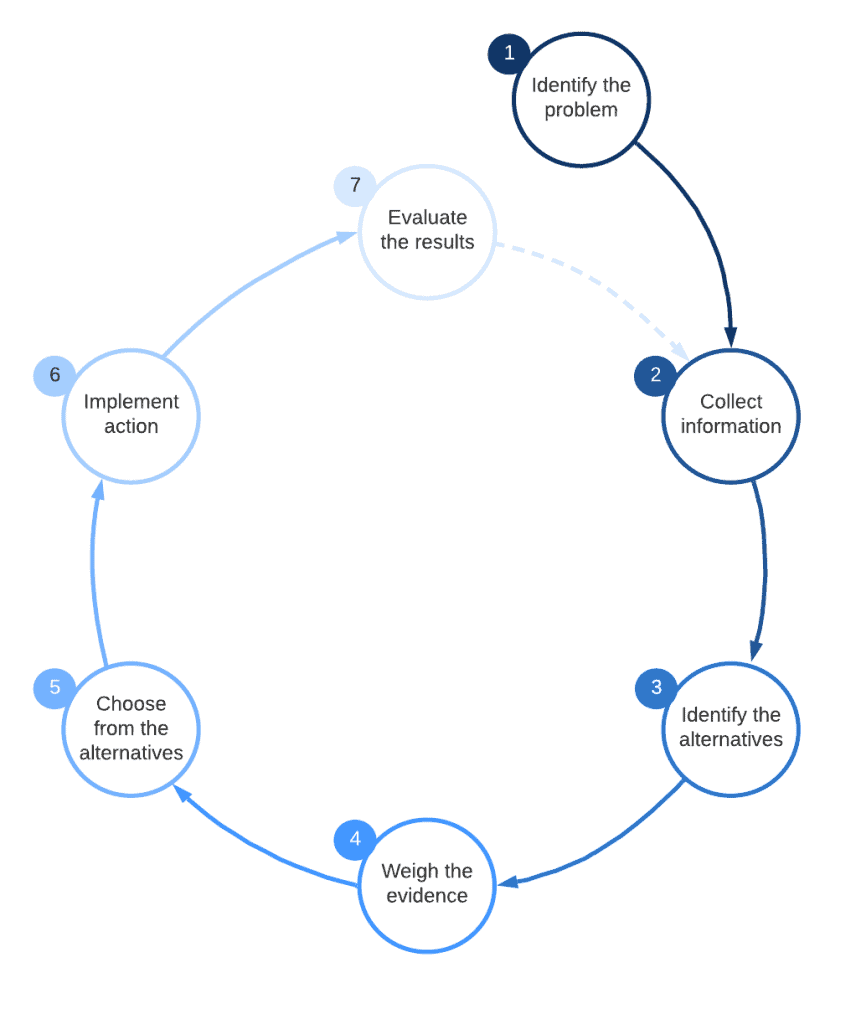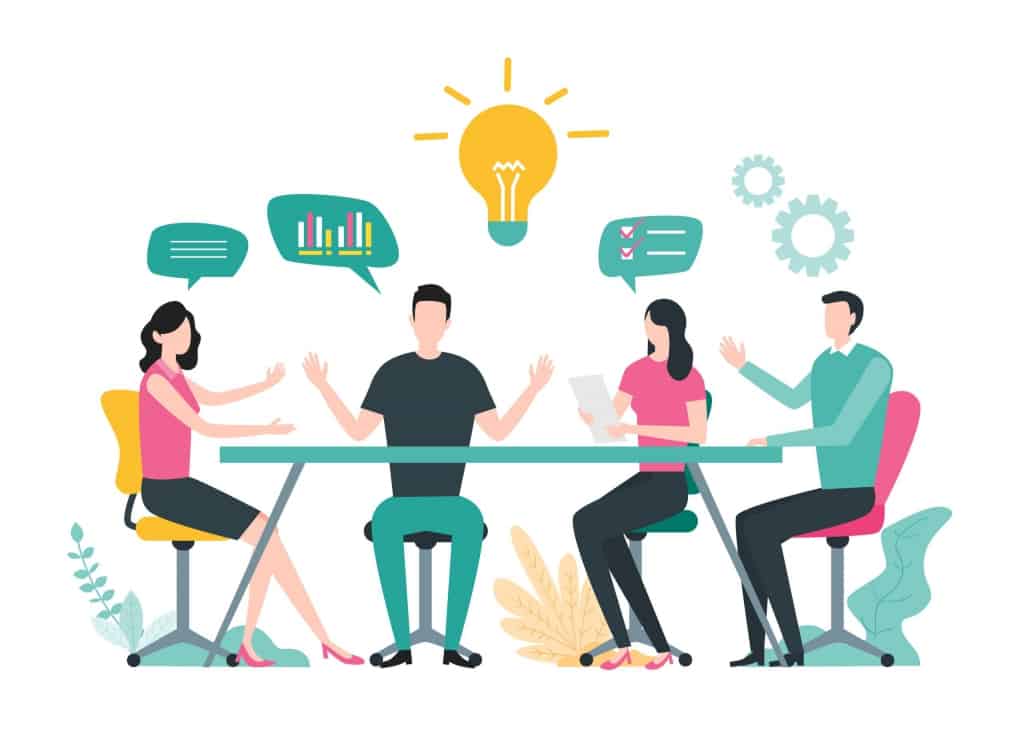Struggling to make choices, so let's check out best decision making examples, tips, and strategies to get insight into how to make decisions in different situations.
We encounter decision-making examples in everyday life, from routine, like what is today's outfit, what I can eat in dinner to more important events like would I better start-up in high-tech industry, or which marketing plan is more effective, etc.
In the decision-making process, people intend to consider different alternatives for obtaining the best outcomes with least resources consumption, in the other words, success. So, which accounts for business or personal success? Without the right decision making, is it possible to maintain a thriving company?
Table of Contents
In this article, you'll learn:
- Overview
- What is a decision making process?
- What are 3 types of decision-making?
- Why is decision making important and its benefits?
- What are best decision making examples?
- Make Decision Making Process more fun with AhaSlides
- Final Thoughts
- Frequently Asked Questions
Tips with AhaSlides
- Leadership style examples
- Transformational leadership example
- Process of strategic management
- Creative Problem Solving Examples
- Customer Service Training for Employees

Looking for a tool to engage your team?
Gather your team members by a fun quiz on AhaSlides. Sign up to take free quiz from AhaSlides template library!
🚀 Grab Free Quiz☁️
Overview
| When should you make a decision, according to psychology? | The morning time, between 8 a.m. and 1 p.m. |
| Where does decision-making occur in the human brain? | In the prefrontal cortex (PFC) and hippocampus. |
What is a Decision Making Process?
A decision-making process is a systematic approach to making choices and selecting courses of action based on a set of criteria and available information. It involves identifying a problem or opportunity, gathering relevant information, considering various options, evaluating the options based on a set of criteria, and selecting the best option based on the evaluation.
The decision-making process typically involves the following steps:
- Define the problem or opportunity: Identify the issue or situation that requires a decision.
- Gather information: Collect relevant data and information related to the problem or opportunity.
- Identify options: Generate a list of potential solutions or courses of action.
- Evaluate options: Analyze the pros and cons of each option, considering the potential risks and benefits.
- Select the best option: Choose the option that best meets the criteria and solves the problem or takes advantage of the opportunity.
- Implement the decision: Develop an action plan and execute the chosen option.
- Evaluate the outcome: Assess the effectiveness of the decision and identify any areas for improvement.

What are the 3 Types of Decision-Making?
Understanding the type of decision-making required in a given situation can help individuals or organizations allocate resources, time, and effort more effectively to make the best possible decision. Here are there types of decision-making in terms of management:
- Operational decision-making: This type of decision-making is made in response to a well-known, repetitive situation that has a predictable outcome day by day. These decisions are usually made quickly and with minimal effort. Regular ordering of supplies/creating staff rota is among many decision making examples.
- Tactical decision-making: This type of decision-making is made in response to a familiar situation, but one that requires a bit more analysis and evaluation. Tactical decisions are often made by mid-level managers who have to balance conflicting goals and objectives. Deciding which marketing campaign to launch for a new product is among many decision making examples.
- Strategic decision-making: This type of decision-making is made in response to a unique, complex situation that has a significant impact on the organization's future. Strategic decisions are often made by top-level executives and require extensive analysis and evaluation of different options. Deciding whether to expand the company's product line or enter a new market is among many decision making examples.

Why is Decision Making Important and Its Benefits?
Decision making is important because it helps individuals and organizations to make informed and wise choices that can lead to better outcomes and improved performance. With these following points, there is no reason to ignore the decision making process.
- Achieving goals: Good decision making helps individuals and organizations to achieve their goals. By making informed and wise choices, they can make progress towards their objectives.
- Problem-solving: Decision making helps in solving problems by identifying and analyzing issues, and finding the best solutions to address them.
- Efficiency: Good decision making can help in reducing time, effort, and resources required to achieve a particular goal. It can help individuals and organizations to be more efficient and productive.
- Improved outcomes: Making good decisions can lead to positive outcomes, such as increased revenue, customer satisfaction, employee engagement, and profitability.
- Risk management: Making effective decisions examples helps manage risks by identifying potential problems and making contingency plans to minimize their impact.
- Personal growth: Decision-making can help individuals to develop critical thinking and problem-solving skills, which are essential for personal growth and development.
What are the Best Decision Making Examples?
Best decision making examples of Centralized decision making
Centralized decision making refers to a decision-making process where a single individual or group of individuals has the authority and responsibility to make decisions for an organization or group, often made by the most experienced people. The decisions made are binding and must be adhered to by all members of the organization. Here are some centralized decision making examples that you can refer to:
- Military organizations: In military organizations, decisions are often made by a central command structure. The orders issued by commanders must be followed by all members of the organization.
- Corporate organizations: In corporate organizations, senior management is responsible for making key decisions that affect the direction and operations of the company. Best decision making examples are decisions relating to mergers and acquisitions, product development, and market expansion are typically made by senior executives.
- Government organizations: In government organizations, decisions related to policy and legislation are made by elected officials and appointed bureaucrats. These decisions are binding and must be followed by all members of the government and the public.
- Education institutions: In educational institutions, decisions related to curriculum, course offerings, and academic standards are made by a central administration. Faculty members must adhere to these decisions to maintain accreditation and meet student needs.
- Non-profit organizations: In non-profit organizations, we can see many good decision making examples, such as decisions related to fundraising, program development, and volunteer management are often made by a central board of directors. These decisions must be adhered to by staff members and volunteers in order to fulfill the organization's mission.

Best decision making examples of Decentralized decision making
Decentralized decision making refers to a decision-making process where authority and responsibility are distributed among multiple individuals or groups within an organization or group. Each group or individual has a certain level of autonomy to make decisions within their own area of expertise. The decisions made are usually based on the local team, and there is more room for flexibility and creativity in the decision-making process.
There are many excellent decentralized decision making examples as follows:
- Holacracy: Holacracy is an outstanding decision making example as it follows a management philosophy that emphasizes self-organization and decentralized decision making. It replaces traditional management hierarchies with a system of self-governing circles, where each circle has the authority to make decisions within their area of expertise.
- Agile methodology: Agile methodology is an approach to project management that emphasizes collaboration and decentralized decision making. The team members are empowered to make decisions based on their area of expertise and are encouraged to work together to achieve a common goal.
- School-based management: For decision making examples in education, school-based management is a good one. It emphasizes a decentralized approach to decision making where schools are given more autonomy to make decisions related to curriculum, budgeting, and staffing.
- Cooperatives: Cooperatives are organizations owned and controlled by their members, who make decisions through a democratic process. Each member has an equal say in the decision-making process, and decisions are made based on the needs and priorities of the members.
- Open-source software development: Open-source software development refers to the code being made freely available to the public, and anyone can contribute to its development. Decisions about the direction and development of the software are made through a collaborative process that involves a large community of contributors.

Tips for Decision Making Process More Fun with AhaSlides
AhaSlides is an online tool that can help make decision-making more fun and engaging. Here are some ways AhaSlides can enhance your decision-making process:
- Interactive voting: AhaSlides allows you to create interactive voting sessions where participants can vote on different options using their smartphones or other devices. This makes the decision-making process more engaging and encourages participation from everyone involved.
- Real-time feedback: AhaSlides provides real-time feedback on the results of the voting session. This allows you to see the results and make decisions based on the feedback you receive.
- Visual aids: AhaSlides provides visual aids, such as charts and graphs, to help you interpret the results of the voting session. This makes it easier to understand the feedback and make informed decisions.
- Collaboration: AhaSlides allows for collaboration among participants, which can improve the decision-making process. Participants can share ideas, discuss options, and work together to come up with the best solution via live Word Cloud feature.
- Spinner Wheel: When it comes to hilarious decision-making like making random choices, you can customize options and spin the wheel to reveal the result without bias.

Final Thoughts
All in all, many factors affect decision-making. It needs more practice to make the right decision. Besides learning from decision making examples, it is necessary for people to improve themselves with other leadership skills to make better choices, especially when facing difficulty.
Ref: BBC
Frequently Asked Questions
What are decision making examples for students?
Students often encounter various decision-making situations throughout their academic journey. Here are some examples of decision-making scenarios that students may encounter, including course selection, time management, study techniques, extracurricular activities, internship and job offers, to see if they should study abroad, work on research or thesis topics and for their post-graduation plans.
What are responsible decision making examples?
Responsible decision-making involves considering ethical, moral, and long-term consequences when making choices, with examples including environmental consciousness, ethical dilemmas, peer pressure and substance use, academic integrity, online behavior and cyberbullying, financial responsibility, health and well-being, social responsibility and civic engagement, conflict resolution and responsible use of technology.








